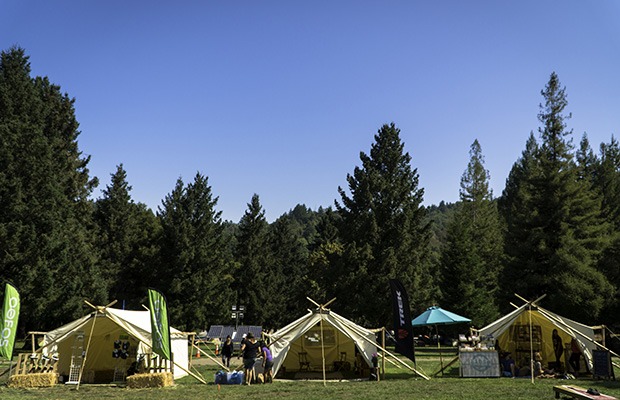Ask me the best and worst thing about living in New York, and I’d say it’s the hustle. The city’s energy instills a relentless drive to do better, work harder and achieve more. But that can also translate to more time with your head down (likely staring at a tiny screen), and less time reveling in moments spent with friends, wandering the city, or simply getting outside. In other words: Goodbye Girl Scout glory days and weekends camping in the PA woods; hello long work days and some mood-busting subway commutes.
The trouble with that is, being cooped up inside can certainly take a toll on both your physical and mental health. Meanwhile, science backs up what most of us probably know to be true — that nature gives your body and brain a serious reboot.
So, when the Camelbak Pursuit Series beckoned me to San Francisco, I knew I had to answer to some outdoor adventures. Similar to events like REI Outessa or Wanderlust, the Camelbak weekend allows you to pack in as many activities as possible, including rock climbing, stand-up paddleboarding, trail running and classes in yoga, backpacking and photography — all amidst the picturesque California Redwoods.
Fast-forward three device-free days later, and I realized that the blissful benefits of a date with nature are real. Here’s why you might just want to follow suit and book your own getaway ASAP.
7 Reasons to Plan More Outdoor Adventures This Season
1. The mood-enhancing rumors are true.
Think about how good it feels to step away from your desk and onto the sidewalk for a walk around the block. Now imagine doing that for a full weekend — except with a little more greenery around you. Research shows that people who take just a 90-minute walk in nature experience a reduction in brain activity associated with mental illness like depression. Similarly, strolling with other people has been shown to increase feelings of positivity. When you’re feeling drained from the week, take your stride — and your bestie — to a tree-lined block.
2. The minutes seem to slow down.
Time flies when you’re paddling through open waters or sitting by a fire with live music, a beer and new friends. But being outside also gives you the sense that you actually have more minutes to enjoy what’s around you — especially when you put down your phone and put the kibosh on multi-tasking. So when I had time between activities to hang in my tent, I didn’t check Instagram 10 times for new followers. Instead, I just laid on my cot. (OK fine, there was no cell service anyway.) Lo and behold, I found myself thinking about how much I appreciated the moment — not an everyday thought when rushing around the city to make a meeting or catch a train.
Sure enough, science shows how tuning out of notification overload and into a single activity gives your brain a much-needed break, considering multi-tasking can lead to mental fatigue. “When we’re constantly multitasking and responding to emails and working through the to-do list… we’re overtasking the frontal cortex [of the brain],” explains Florence Williams, author of The Nature Fix and frequent contributor to Outside magazine. “That makes us grumpy and fatigued, and eventually, it makes us not so sharp,” she says. “The brain is like a muscle and it helps to rest it at times. And that’s what nature does, helps us rest our minds.”
3. You come back less stressed, more focused.
It’s no secret that spending time among the trees can help you de-stress while perking up productivity, thanks to the positive feelings that cultivate in nature, as well as the above mentioned ability to disconnect. (And vacations almost always work as a way to recharge.) But studies even link healthier levels of cortisol, or the stress hormone, to areas with more green space. Translation: Those who live near more grass and trees tend to feel more relaxed. (This is especially true for women, more so than men, according to research.) Even more important, spending time in green space has also been linked to a longer life.
4. You actually get in tune with your senses.
You’ve probably read about the benefits of mindfulness for mental health. Well, being outside makes mindful meditation a little easier, because you’re exposed to more pleasing scents, beautiful sights and soothing sounds. This idea follows principles similar to forest bathing — or taking a walk in nature, as you pay closer attention to the details you spot in leaves or bark, the sounds of waves crashing onto the shore, or whatever else fills your surroundings. Research links these sensory-enhancing walks through the woods to lower blood pressure and fewer stress markers, compared to taking a stroll through city streets.
“Being outdoors heightens your senses in a way that cannot be replicated indoors,” says Kirsten Beverley-Waters, founder of Thryve fitness and yoga instructor for the Pursuit Series. “The fresh air elevates your breath awareness, which makes it easier to become more self-aware and present in your breathing. Nature becomes this incredible facilitator of unplugging from the distractions around us and dropping into what our body really needs,” she says.
5. You experience that “awe” feeling.
When you take in a pretty waterfall, a breathtaking landscape or a park covered in gorgeous greenery, you’ve already achieved something: immersing yourself in the moment. “The science of awe is pretty new, but seems to suggest that when we experience awesome beauty, we react in ways that are more generous and community minded,” Williams explains. “It makes us think we’re a part of something that’s bigger than ourselves and we feel a little less stressed out.”
Another thing about getting your feet wet with different outdoor adventures is that you get to experience the world from new vantage points. “Each activity gives a different perspective,” says Julia Stamps Mallon, co-founder of CamelBak Pursuit Series and Eventus Outdoors. “For instance, when you rock climb and you’re on the edge of a cliff overlooking a valley, that’s a different feeling [and landscape] than catching a wave and riding into shore.” Though equally beautiful, different experiences with nature make you more thankful for it — and probably make you want to indulge in it more.
6. Nature becomes your gym.
Working out outdoors can actually amplify results — and lead to even more health improvements. In fact, people who exercise outside the studio report more feelings of enjoyment, often sweat it out for longer periods of time and tend to expend more energy(at least in terms of running).
“When you’re in a gym, you’re often not as stimulated and you’re on consistent surfaces,” Williams says. “Outside, you have to balance and make micro adjustments to find that balance.”
Beverly-Waters agrees that taking your yoga practice outside can change the experience, too. “Cuing students to hear outside noises changes the energy of the practice,” she says. “Using directional cues such as, ‘ground down into the earth, extend your arms up to the sky’ — ‘instead of ground down through your mat, reach up to the ceiling,’ changes a student’s [experience].”
I felt this first-hand during Beverly-Waters’ Pursuit yoga class, when we got to stretch it out and enjoy savasana with Redwood trees encircling us. Picture laying in yoga’s most relaxing pose, basking in true earthy beauty. It was the quintessential zen cocktail.
7. You find new favorites (people and activities).
Beyond taking your typical gym routine to the grass, the outdoors also gives you more options to switch up your workout, adding exciting new elements and greater challenges. While you may work on pull-ups at CrossFit, rock climbing lets you put it into practice. Similarly, rowing a kayak lets you put your back-strengthening exercises to good use. Plus, there’s nothing like conquering a steep climb or nailing a gnarly trail to boost your confidence.
“We want people to find the opportunity to connect and pursue their outdoor desires,” says Mallon. “So even if you’re a pro in one area, you may not be proficient in another, [and Pursuit gives you] the chance to try something new and to soak it up with friends, family and a new community.”
By the end of a Pursuit Series weekend, “people have shared a variety of experiences that have challenged them. They’ve learned new skills together, they’ve been afraid together and they’ve celebrated at night together,” says Bart Davis, co-founder of the Pursuit Series. “Our participants arrive as strangers and they leave as a community.”
For the record, this is precisely how I felt come Sunday. Well, that and I certainly didn’t want to head back indoors where my laptop becomes my BFF.
How to Connect with Nature Every Day
Of course, we know it’s not so easy to slip away from the office and into the woods. So when you can’t get away, learn to take a few more breaks to find the beauty in nature — even if your surroundings involve more concrete than bark or rock.
First and foremost, Williams suggests taking out those earbuds and actually listening to the sounds around you (screeching cars even count). It also helps to go for a short walk in the morning to help reset the circadian rhythm and start the day with a positive mindset. Other ideas Williams swears by: eating lunch outside, choosing a tree-lined street to walk down or simply sitting by a window while you work.
“I think that we’re at a crossroads right now, because a lot of us are recognizing that we’re way more tied into technology than we should be, and we know that doesn’t always make us feel well rested and happy,” says Williams. “Nature is an obvious antidote. Some people love water, woods or trees — and you don’t have to like them all — but figure out what you do enjoy and go to those spaces that make you feel good.”
Williams has a mantra that I plan to borrow from here on out: “Go outside, go often, bring friends or not, and breathe.”









